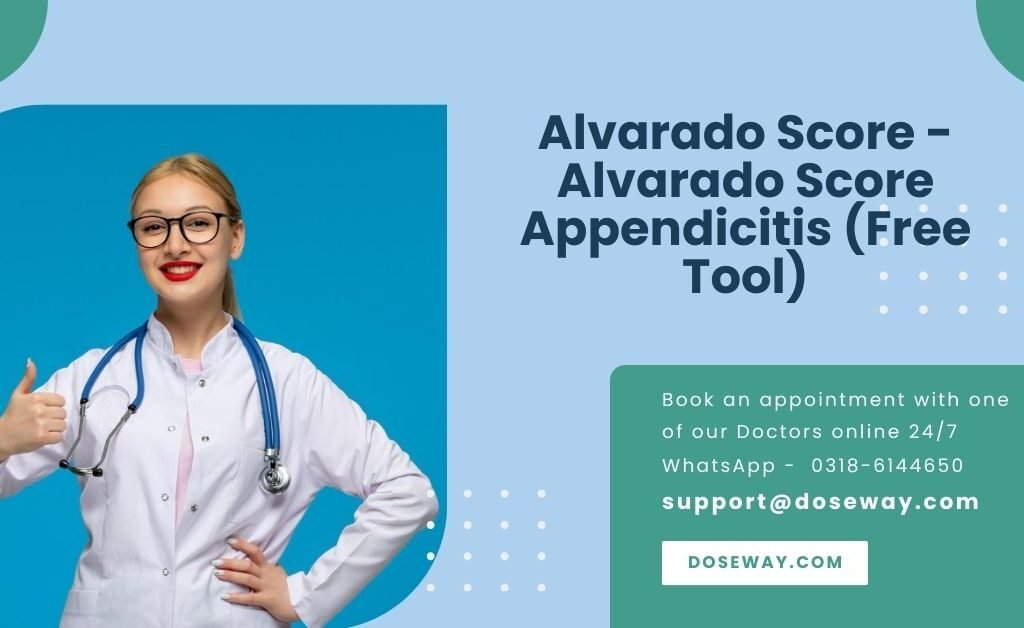Acute appendicitis is a medical emergency requiring immediate intervention. The Alvarado Score (MANTRELS score) is a globally validated clinical tool that quantifies appendicitis risk through symptoms, signs, and lab findings.
This guide explains:
✓ How the Alvarado Score prevents life-threatening complications
✓ Real-time calculation using our free digital tool
✓ Interpretation of low/intermediate/high-risk results
✓ Surgical vs. non-surgical management protocols
✓ Preventive strategies backed by gastroenterology research
Alvarado Score Calculator
Patient Information
Clinical Parameters
Try More Free Tools:
- Try our Osteoporosis Risk Calculator (Osteoporosis Risk Score)
- Try our Calories In 1 Teaspoon Of Sugar (4.2 g White Sugar)
- Try our Calories In 1 Banana (Free App)

Table Of Contents
What Is Appendicitis and Why Is Early Diagnosis Critical?
Appendicitis is the acute inflammation of the appendix, a 3.5-inch tubular structure attached to the cecum. Without prompt treatment, it progresses to perforation within 48-72 hours in 25% of cases, causing sepsis and mortality.
Key Pathophysiological Stages
- Luminal Obstruction
- Fecaliths (hardened stool), lymphoid hyperplasia, or tumors block the appendix
- Bacterial Overgrowth
- E. coli and Bacteroides spp. multiply, triggering inflammation
- Ischemia and Necrosis
- Pressure buildup compromises blood supply
- Perforation
- Rupture spills infected material into the peritoneum
The Alvarado Score: How This Clinical Tool Saves Lives
Developed by Dr. Alfredo Alvarado, this 10-point diagnostic system evaluates eight parameters. It reduces CT scans by 28% (per Annals of Surgery) while maintaining 96% sensitivity for high-risk cases.
Scoring Criteria (MANTRELS Acronym)
| Parameter | Points | Clinical Significance |
|---|---|---|
| Migration of pain | 1 | Pain shifts to RLQ (McBurney’s point) |
| Anorexia | 1 | Appetite loss precedes nausea |
| Nausea/vomiting | 1 | Late symptom indicating progression |
| Tenderness (RLQ) | 2 | Maximal pain at McBurney’s point |
| Rebound tenderness | 1 | Peritoneal irritation sign |
| Elevated temperature | 1 | >37.3°C (99.1°F) |
| Leukocytosis | 2 | WBC >10,000/μL |
| Shift to left (neutrophils) | 1 | >70% neutrophils |
How Our Alvarado Score Calculator Works
The calculator transforms complex clinical data into actionable insights through four steps:
Step 1: Patient Demographics
- Age: Children <5 years and adults >50 exhibit atypical symptoms
- Gender: Females require pelvic exams to rule out ovarian pathology
Step 2: Symptom Input
- Pain migration patterns:
- Visceral pain (periumbilical) → Somatic pain (RLQ)
- Gastrointestinal symptoms:
- Anorexia sensitivity: 78%
- Vomiting PPV: 61%
Step 3: Physical Exam Findings
| Sign | Technique | Positive Likelihood Ratio |
|---|---|---|
| McBurney’s sign | Deep RLQ palpation | 3.4 |
| Rovsing’s sign | Left-sided pressure causes RLQ pain | 4.2 |
| Psoas sign | Right hip extension elicits pain | 2.3 |
Step 4: Laboratory Integration
- Leukocytosis unit converter:
- Toggle between ×10³/μL and ×10⁹/L
- Neutrophilia thresholds:
- 70-85%: Moderate risk
- 85%: High risk
Interpreting Your Alvarado Score: Evidence-Based Protocols
Low Risk (0-4 Points)
<details> <summary><strong>Clinical Implications</strong></summary> Probability of appendicitis: <15% </details>
Management Pathway:
- Discharge with safety-netting advice:
- “Return if fever >38°C or pain localizes to RLQ”
- Alternative diagnoses to consider:
- Gastroenteritis (norovirus/rotavirus)
- Mesenteric adenitis
- Ovarian cyst rupture
Intermediate Risk (5-6 Points)
<details> <summary><strong>Clinical Implications</strong></summary> Probability of appendicitis: 40-65% </details>
Diagnostic Protocol:
- Imaging selection guide: Modality Sensitivity Use Case Ultrasound 78% Children/pregnant women CT scan 94% Adults
- Observation pathway:
- Re-evaluate score at 6-hour intervals
High Risk (7-10 Points)
<details> <summary><strong>Clinical Implications</strong></summary> Probability of appendicitis: >90% </details>
Emergency Actions:
- NPO status (nothing by mouth)
- IV antibiotics:
- Ceftriaxone 2g + Metronidazole 500mg
- Surgery within 6 hours:
- Laparoscopic vs. open appendectomy
Appendicitis Treatment: Surgical vs. Non-Surgical Approaches
Antibiotic-First Strategy
Candidates: Uncomplicated appendicitis (no perforation, phlegmon, or abscess)
Regimen (EAST guidelines):
- IV ertapenem x 48 hours → Oral moxifloxacin x 7 days
Success rate: 72% at 1 year (CODA Trial)
Appendectomy Techniques
| Technique | Operative Time | Hospital Stay | Complication Rate |
|---|---|---|---|
| Laparoscopic | 45 min | 1-2 days | 3% |
| Open | 35 min | 3-5 days | 11% |
Preventing Appendicitis: 5 Evidence-Backed Strategies
While no method guarantees prevention, these reduce risk:
1. High-Fiber Diet
- Mechanism: Reduces fecalith formation
- Daily target: 30g fiber (beans, berries, broccoli)
2. Hydration Optimization
- Goal: >2L water/day to maintain bowel motility
3. Probiotic Supplementation
- Lactobacillus spp. lower enteric inflammation
4. Prompt GI Infection Treatment
- Parasitic infections (e.g., Entamoeba) increase obstruction risk
5. Smoking Cessation
- Tobacco use doubles perforation risk (per JAMA Surgery)
Frequently Asked Questions (FAQs) –
Can Children Under 12 Use the Alvarado Score?
Yes, but the Pediatric Appendicitis Score (PAS) improves accuracy by adding cough/hopping pain.
What If Pregnancy Causes Elevated WBC?
Use adjusted thresholds:
1st trimester: WBC >16,000/μL
3rd trimester: WBC >18,000/μL
How Accurate Is the Alvarado Score vs. CT Scans?
Sensitivity
Specificity
Alvarado ≥7 96% 81%
CT scan 94% 95%
Can I Have Appendicitis With a Low Score?
Yes. Atypical presentations occur in:
Elderly: 40% lack classic symptoms
Immunocompromised: Corticosteroids mask inflammation
Is Surgery Mandatory for High Scores?
Immediate antibiotics are alternatives for:
Surgically high-risk patients
Uncomplicated cases in resource-limited settings

 Cart is empty
Cart is empty
Add a Comment